I am not an expert on I2-Y3120 or I2-PH908.
Everything I wrote today was from having spent several hours studying the samples on the YFull tree and looking at the relative frequency heatmaps generated by Y Heatmaps from the samples on the YFull tree.
My haplogroup, J2b-L283, has been in the Balkans since the Bronze Age so I decided to read "The Early Medieval Balkans" by John V. A. Fine, Jr. in order to better understand historic events that could have impacted the survival or migrations of male lines.
I just finished reading his analysis of the migrations of the Slavs into the Balkans and decided to look at the distribution of the various children of I2-Y3120, many of which appear to have taken part in these, and other, migrations.
I realize relative frequency heatmaps do not necessarily show the areas of highest diversity, which are more likely to indicate a haplogroup's origin than the relative frequency. However if you are careful to understand founding effects and check the diversity and ancient samples in the tree yourself, this visualization crunches a large amount of data into a meaningful metric that can guide your reasoning.
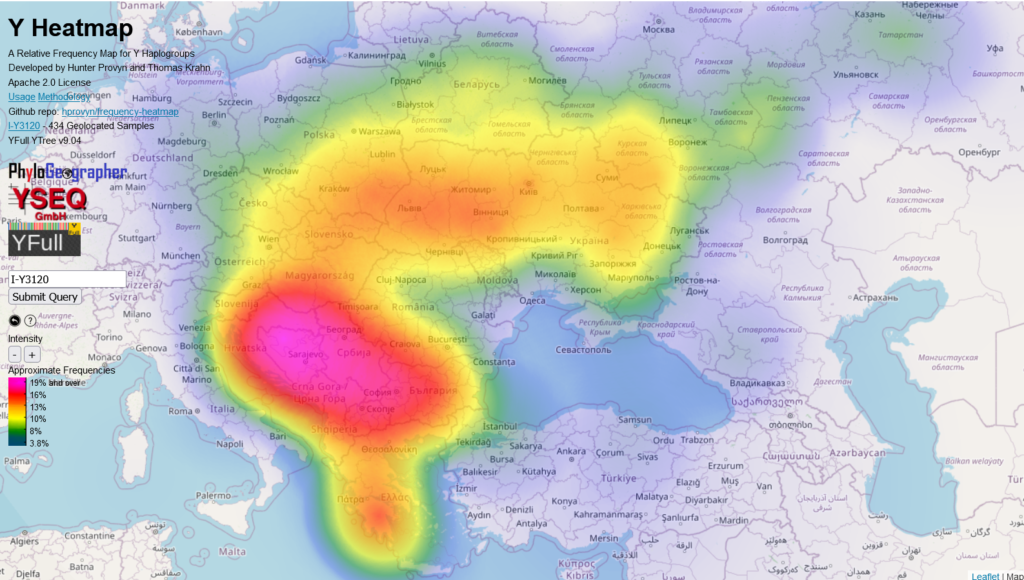
I2-Y3120 was bottlenecked from 1400-200 BC
This man's ancestors went through a rough period where no other siblings survived except his own direct male line ancestors. This started in 1400 BC and ended 200 BC.
If you look at how many SNPs comprise each of his child lineages, you can infer the following:
- He had three sons* that were the most successful in terms of being prolific, I2-Y18331, I2-Z17855, I2-Y4460
- A fourth son was not as prolific himself, but several generations later, one of his line founded a new dynasty, I2-S17250.
- Through this dynasty, the fourth son would ultimately have more descendants than all the rest of his siblings put together
*These three lines are defined by a single SNP, which may actually have taken several generations to arise
Now lets look at the modern geography of each of these sons' offspring.
I2-Y18331 Somehow Destined for Greece in 200 BC?
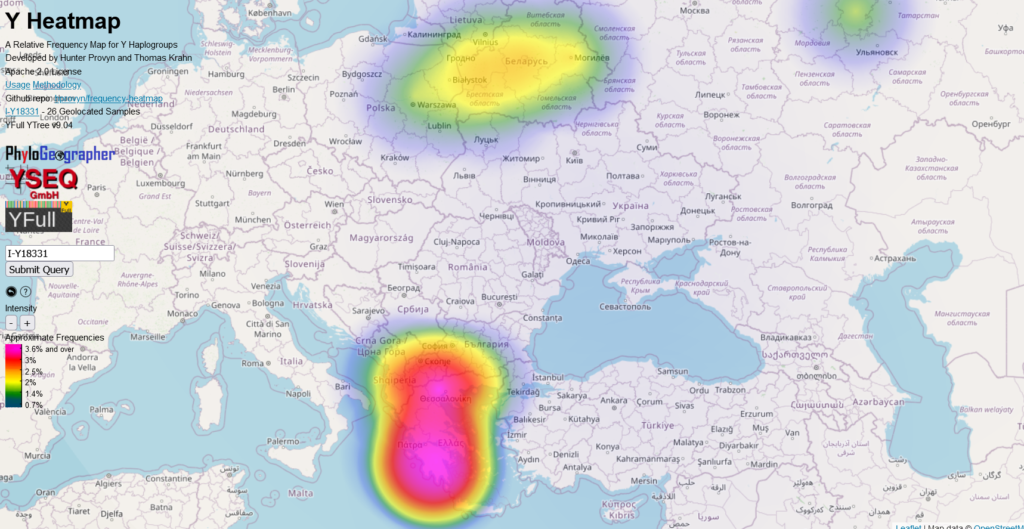
It's good that this one comes first on the YFull tree because I think it's the most interesting.
This relatively small lineage comprises over half of all the Greece samples in I2-Y3120 on YFull. This 10 of 18 Greece samples figure does however diminish a little if you ignore founder effects in the last millennium - it becomes 6 of 13. Still, I2-Y18331 is punching well above its weight in Greece relative to the other lineages.
So where were these guys living before they migrated to Greece? Did this location somehow contribute to the destiny of many of these men to migrate to Greece 800 years later?
Interestingly, all of these men who migrated to the Balkans wound up in Greece, Albania or North Macedonia (one guy) or neighboring countries and none became Serbo-Croatian.
There are no relatives living in any other nearby countries to provide an idea of from where they originally came.
The heatmap shows there are a number of samples between Masovia and Belarus. Most of the heat is caused by a founder effect but it is worth noting that the only two Polish samples in this subclade are distantly related to each other (one is basal) and from Masovia.
The other clue is the sample from Ukraine but he didn't indicate from where in the Ukraine he is from.
So I'm not answering this question for now.
But we can consider the theory that I2-Y18331 and/or his sons migrated somewhere, possibly joining or forming a separate political entity, which much later decided to take part in a migration to Greece.
Edit: When I wrote this article I didn't know that child I2-Y23115 from Belarus and neighboring countries was 100% Eastern Ashkenazi. When I have time to process that I'll probably edit this section.
One implication to this is that it seems more likely that the ancestor was living in Greece by approximately 200 BC. In this case we may be looking at Celts that had invaded Greece in 279 BC. The estimate is very close given the error range. Wow, mind blown.
I2-Z17855 Migrate to Bulgaria and Northern Macedonia
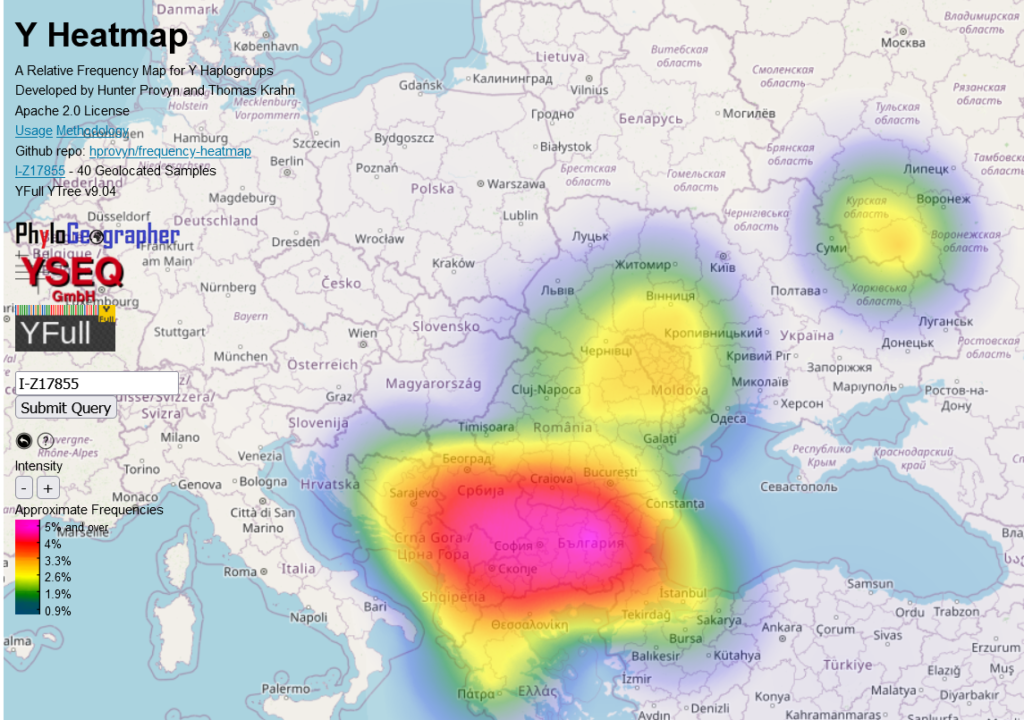
I2-Z17855 is most prevalent in Bulgaria, North Macedonia and part of southern Serbia. There is only a single sample in Greece.
There are several samples from Ukraine and a sample each from the undersampled countries of Romania and Moldova. Poland only has one sample.
This could mean that this son or dynasty of I2-Y3120 had migrated to somewhere around SW Ukraine or Moldova that is indicated in yellow on the map.
I2-Y4460

I2-Y4460 has highest frequency in the Ukraine.
There are no samples from Serbia, Bosnia or Croatia on the YFull tree. The only thing close are a lone Slovenian and a Bosnian from Montenegro. That Bosnian from Montenegro could actually descend from a very different migration - one from Turkey.
Interestingly, one child lineage of I2-Y4460 did migrate to Greece. It is called I2-Y70430 and has a TMRCA of 500 AD. Like the guys we looked at earlier who went to Greece, their closest relatives are found in Belarus as well.
This connection between Belarus and Greece could mean:
- The tribes that went to Greece had been originally living in Belarus
- The relatives of the men that went to Greece moved to Belarus later
- Coincidence
I2-Y4882
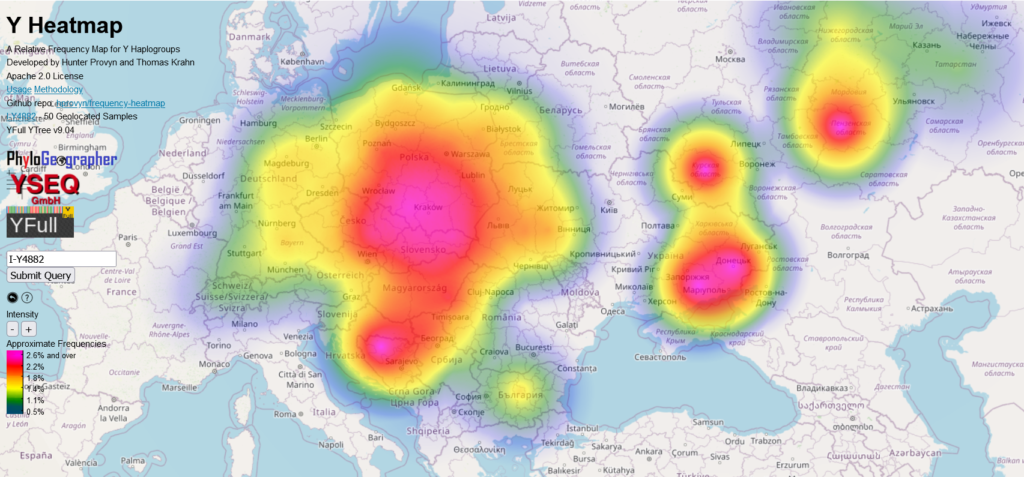
Now we're looking at the children of the prolific fourth son's dynasty I mentioned in the beginning.
The highest frequency of I2-Y4882 is southern Poland around Krakow, northern Slovakia and eastern Moravia.
His offspring didn't migrate much to the Balkans. There are a few samples in the eastern parts of Germany, one is an ancient sample from Krakauer Berg in Sachsen-Anhalt dating to about 600 years ago.
Five of the six modern Balkanites descend from one man who lived 1250 years ago, I-Y177643. So it's possible that only two descendants of I2-Y4882 migrated to the Balkans.
I2-Y5596
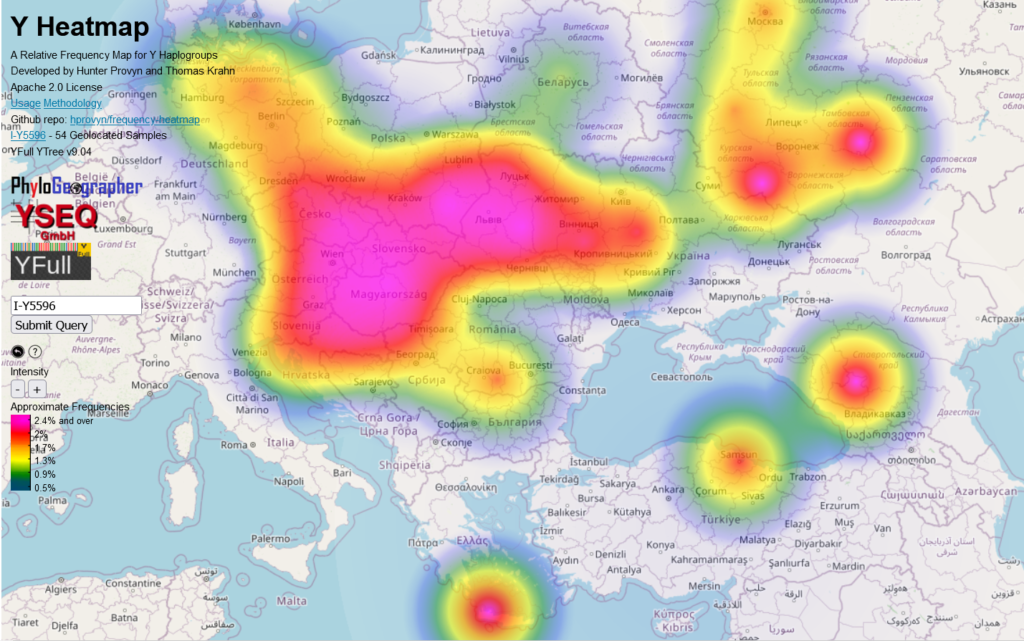
The MRCA of this line lived 1950 years ago.
The highest frequencies of I2-Y5596 are found in an area including Ternopil and Lvov oblasts of Ukraine, Krakow, Moravia, eastern Austria, Slovakia and most of Hungary excepting its eastern border.
There are a few samples from the northern periphery of the former Yugoslavia and a lone Bulgarian.
Five of the Poles in the heatmap descend from just one man who lived 600 years ago - their next closest relative is from Czechia.
There are samples from eastern and northern Germany where we know Polabian Slavs used to live. Except for the Sorbs, Polabian Slavs, such as the Obodrites who lived in Mecklenburg and Holstein, eventually assimilated with the Germans. The Obodrite princes stayed in charge but changed their names to be the House of Mecklenburg.
While there are two distantly related ancient samples from the South Moravia Region that lived 1162 years ago, I think this cannot be the origin because according to historical sources, Slavs didn't come to Moravia until the 6th century. Prior to this there were Germanic and Celtic tribes living there.
So maybe the western Ukraine is a better candidate for the origin of this line.
I2-PH908 Migrates to Serbia, Croatia and Bosnia
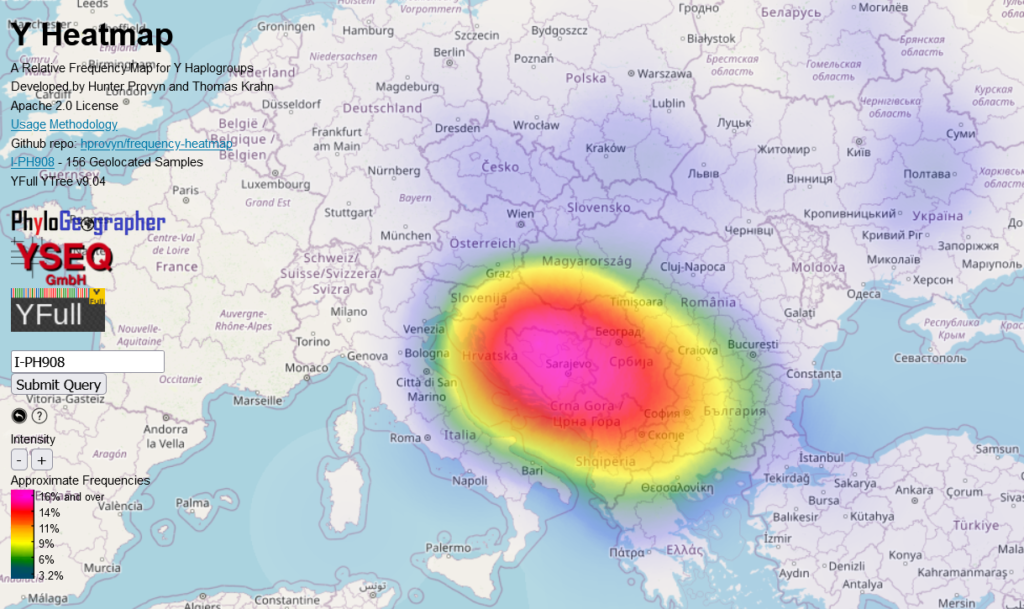
I2-PH908 are most prevalent in Serbia, Croatia and Bosnia and Herzegovina. Their MRCA lived 1700 years ago, which is just a few hundred years before the Slavs migrated to Germany and the Balkans.
Found effects amplify the frequency to be so much greater in the western Balkans vs other Slavic countries.
Discounting the outliers to the east in Russia, it is most prevalent in Ukraine, Slovakia, southeastern Poland and Czechia.
There are no ancient samples on the YFull tree to help us determine the origin.
I think we really need a diversity heatmap to crunch the geolocated samples to get an idea of the possible origin.
One interesting thing I notice is that two of the German samples from regions that were inhabited by Slavs each have a closest relative from the Balkans. The TMRCAs are 1550 and 1350 years ago. So from their homeland, in a space of a few hundred years, these two pairs of relatives each joined different migrating groups that went in completely different directions from one another.
Maybe it would help to analyze each of the major children separately, something I will not do at this time, but someone could commission me through the Patrician tier of PhyloGeographer on Patreon.
Are we sure I2-Y3120 was a Slav?
I thought it would make sense to consider an alternative explanation.
Given that if you go up a few branches on the YFull tree back to I2-L621, the diversity is around Germany, I think that I2-Y3120 may have begun its 1400 BC bottleneck somewhere in or near Germany.
The migration of this man to the east might have been within the context of the Tumulus Culture, Urnfield Culture or Hallstatt Culture. By 200 BC, if he were living in or near the Slavic homeland I can think of no better explanation than that his male line had already been assimilated into the Slavs or formed as they did.
Goths could also be considered but what are the chances that every single one of these Goths assimilated into Slavs rather than taking part in Gothic invasions of Italy and western Europe. Also there is no genetic connection to Scandinavia.
Maybe one theory why R1a is not as common as I2-Y3120 in the Slavic Balkans is because I2-Y3120 were a group that adopted the language and culture of dominant, mostly R1a original Slavic groups that it was fleeing from.
That's all folks - but maybe you can take it further
I am not an expert on I2-Y3120 or I2-PH908.
Everything I wrote today was from having spent several hours studying the samples on the YFull tree and looking at the relative frequency heatmaps generated by Y Heatmaps from the samples on the YFull tree.
These are my own opinions from looking at the data. Others who specialize in this haplogroup's research may have already reached the same conclusions, or different ones.
The goal is to deduce which tribes they belonged to. If researchers feel confident about the geography of a subclade's origin then those with knowledge of ancient tribes can take it to the next step. I'm sure some have already. Hopefully the maps I've linked and some of my observations could be helpful in this next step.
This is a nice map of a Slavic homeland, though because I'm no expert on the Slavic homeland I cannot vouch for its accuracy.
I think we are probably close to understanding where some of these lineages originated. We need more ancient samples, but these days they are rapidly accumulating. We need to test more people from some countries as well.
When we learn anything about one group of ancient Slavs from any branch of science, there is a knock-on effect because it has implications for whoever their closest male line relatives are known to be.
I came to similar conclusions when analyzing my individual branch… from Gravetian culture (Dolni Vestonice/Pavlov/Krems Wachtberg), ~29,000 BC to… Cherven Grods (contemporary borderland of Poland and Ukraine), ~1,100 AD): 🙂
https://youtu.be/mn8lrz0Bkcs
Rgs.
Very interesting and informative. I did my Y-111 dna test about a year ago and currently reading about my Hungarian heritage and my plan is to do something very similar to your research and documentation. I don’t think it will be as thorough as your’s, but it has inspired me to move forward. Thank you for posting.
Hi Daniel,
Thanks! What haplogroup are you? Are you also I2-Y3120?
Make sure you squeeze every drop of information out of your 111 STRs.
You should be able to get a good prediction for a precise subgroup and may be able to determine which men are your distant, though reliable distant relatives on the basis of having lower GD and sharing rare STR alleles.
This is the tool I developed and use to reliably find relatives (sometimes thousands of years distant) on the basis of STRs – if such relatives exist and have tested and joined public projects.
https://phylogeographer.com/str-match-finder.html
best
Hunter
I2 is considered to be the only European-origin paternal DNA. Interesting fact: Bill Gates, Martin Luther and Novak Djokovic share same I2a1 haplogroup. Anyway, here are some of the official data researching that could help understand its origin and timeline:
https://www.eupedia.com/europe/Haplogroup_I2_Y-DNA.shtml
I am I-Y84307 (sub-clade of I2-PH908) according to YSEQ from Berlin, but since it was a panel test and not Y111 or 600 or what have you, I am not on YFULL which asks for a full genome test, and where there are only four I-Y84307 individuals, two members of the same Istrian Slavonic (Slovene or Croat in today’s sense) clan, a Turk whose name was not divulged, and a Serbian from southern Kosovo. Meh…
Thank you for this article!
I’m a Hungarian with the y haplogroup I-S17250 (at the moment I don’t know any further information).
My paternal family is probably come from South Slav territory, but at the moment I don’t have any 100% precise information.
you might hate this considering the history , but Hi I’m a Romanian with the same haplogroup
No hate with this. Since my previous post i’m learned my paternal line came from Slovakia.
Interesting read! I’m downstream of I-Y4882 and have been following the Yfull tree for some time. Really cool to see it develop over the years. Thanks for the mapping contributions – they really help bring things to life!
Hi I’m the lone Greek under I2-Y5596 and am I-Z16971. How do you think my ancestor ended up in Greece? Probably Crete or the Greek island of Kythira?
Hi Peter,
I don’t know much about the early or late medieval history of Crete, but I would consider a Slavic tribes-mediated migration to Greece as one possible vector facilitating your ancestor’s migration to Greece, whereas many others are living in or near Slavic countries.
best
Hunter
You are right that I2-Y3120 was not Slavic. It was brought with Bastarnae (Celtic or Germanic tribes inhabited in the upper Oder river) to the Pripet and the Dnieper river basins in North-West Ukraine and South Belarus in the end of 3rd century (Zarubintsy archaeologacal culture of 3rd c. BC – 1 c. AD). Zarubintsy culture is most eastern La-Tene influenced culture with strong Celtic influence (“urn fields” cremation bural tradition, black-polished pottery, S-conic plates on hill, triangle shield fibulae of Celto-Illyrian type of late La Tene etc.)